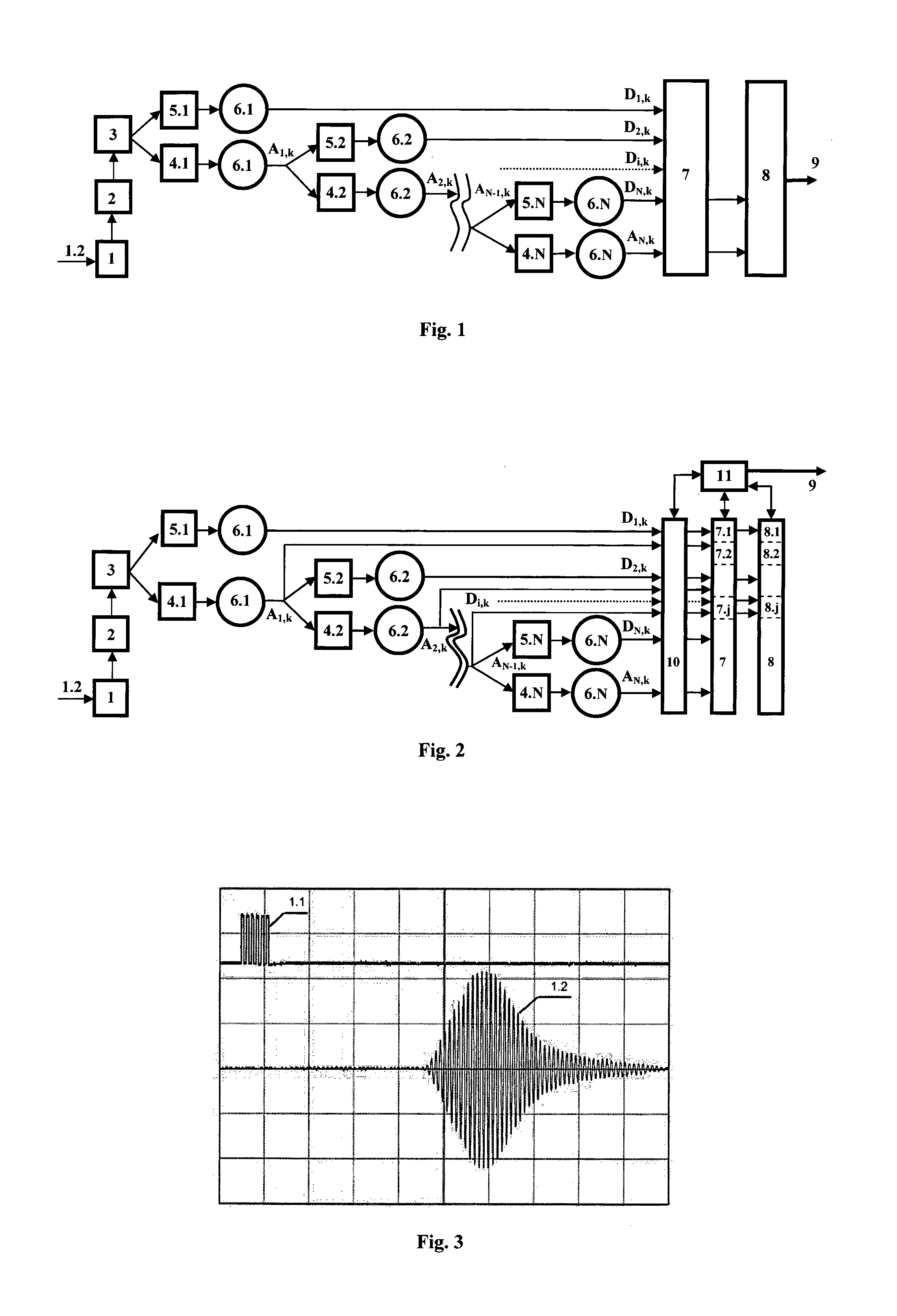Method of Detecting and Identifying Substances or Mixtures and Determining Their Characteristics
- Summary
- Abstract
- Description
- Claims
- Application Information
AI Technical Summary
Benefits of technology
Problems solved by technology
Method used
Image
Examples
embodiment 1
[0027]Referring to FIG. 1 a method of non-contact detection and identification of explosives has been invented which comprises:[0028]irradiation of the inspected object by a single wave pulse with frequency of 40 kHz, produced by a piezo-ceramic ultrasonic emitter (it is not shown) excited by a packet of six rectangular electrical pulses 1.1 with total duration of 150 μs (FIG. 3);[0029]reception of the signal reflected by the inspected object 1.2 by a piezo-ceramic ultrasonic receiver 1;[0030]amplification 2 and analogue-to-digital conversion 3 of the received signal up to 2500 discrete values, and the analogue-to-digital converter is activated at a preset time, depending on the distance to the inspected object.[0031]formation of output detailing wavelet coefficients Di,k and of output approximating wavelet coefficients A7,k by means of fast wavelet transformation of the digitized signal, carried out by Mallat's pyramidal algorithm and Haar's and Simlet's base functions 5, when 7 le...
embodiment 2
[0038]Referring to FIG. 1, a method of detecting and identifying metals and / or their alloys has been invented.
[0039]The method comprises the actions described in Embodiment 1 and the inspected object is also irradiated by a single wave pulse with frequency of 40 kHz, produced by piezo-ceramic ultrasonic emitter excited in a manner similar to Embodiment 1 (FIG. 3), followed by reception 1, amplification 2 and analogue-to-digital conversion 3 of the received signal up to 2500 discrete values and the analogue-to-digital converter is activated at a preset level.
[0040]The digitized signal is processed by means of fast discrete wavelet transformation performed by Mallat's pyramidal algorithm and Haar's orthogonal base functions with the employment of 8 transformation levels comprising high-frequency 4.i and low-frequency 5.i wavelet filtering and binary decimation 6.i after each filtering at each level whereupon output detailing Di,k and approximating A8,k coefficients are formed (FIG. 1 ...
embodiment 3
[0046]A method has been created according to the present invention which has been applied to the detection and identification of plastics (FIG. 1).
[0047]The method comprises the actions described above in Embodiments 1 and 2, and the irradiation of the inspected object is also by a single wave pulse with frequency of 40 kHz, produced by a piezo-ceramic ultrasonic emitter, followed by reception 1, amplification 2 and analogue-to-digital conversion 3 of the received signal up to 2500 discrete values and the analogue-to-digital converter is activated at a preset level.
[0048]The digitized signal is processed by means of fast discrete wavelet transformation by Mallat's pyramidal algorithm and Haar's orthogonal base functions, employing 8 levels of transformation which include high frequency 4.i and low frequency 5.i wavelet filtering and binary decimation 6.i after each filtering at each level, where upon the output detailing Di,k and approximating A8,k coefficients are formed (FIG. 1 an...
PUM
 Login to View More
Login to View More Abstract
Description
Claims
Application Information
 Login to View More
Login to View More - R&D
- Intellectual Property
- Life Sciences
- Materials
- Tech Scout
- Unparalleled Data Quality
- Higher Quality Content
- 60% Fewer Hallucinations
Browse by: Latest US Patents, China's latest patents, Technical Efficacy Thesaurus, Application Domain, Technology Topic, Popular Technical Reports.
© 2025 PatSnap. All rights reserved.Legal|Privacy policy|Modern Slavery Act Transparency Statement|Sitemap|About US| Contact US: help@patsnap.com



